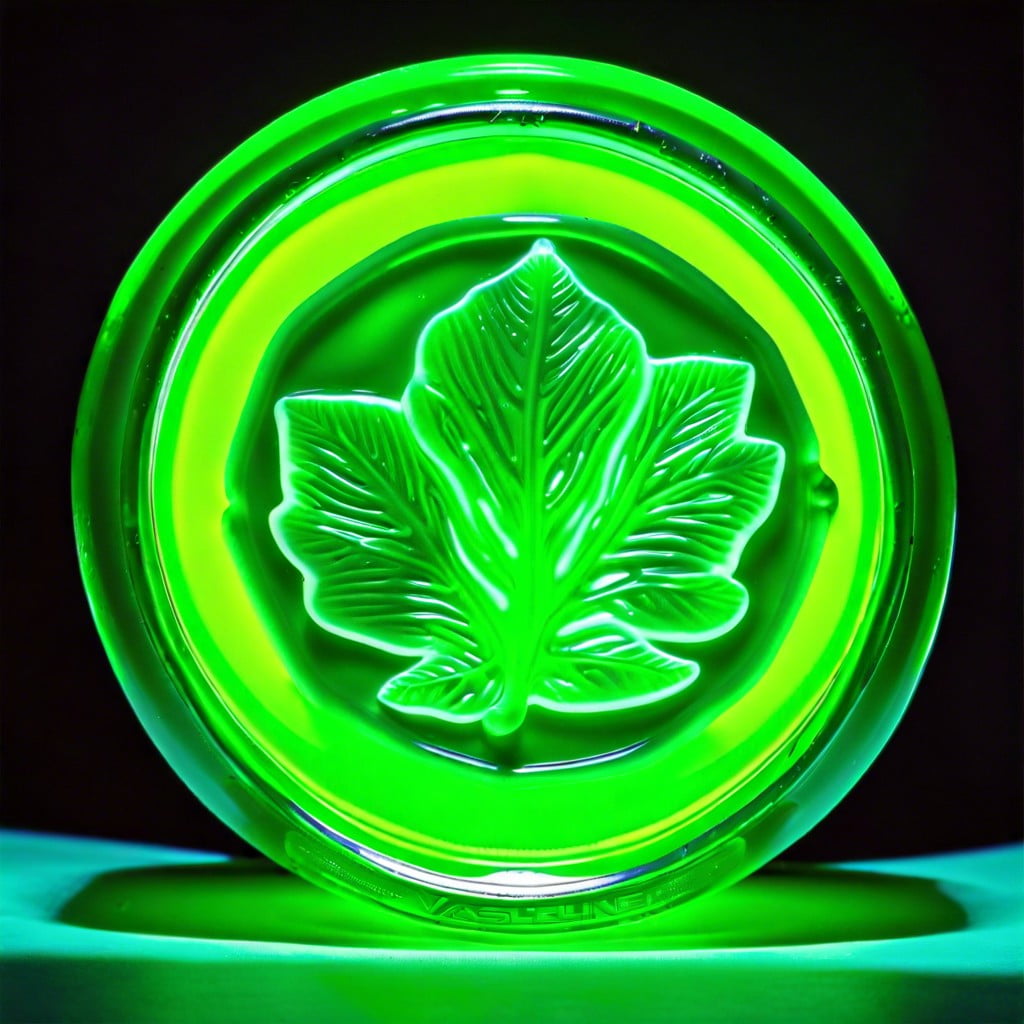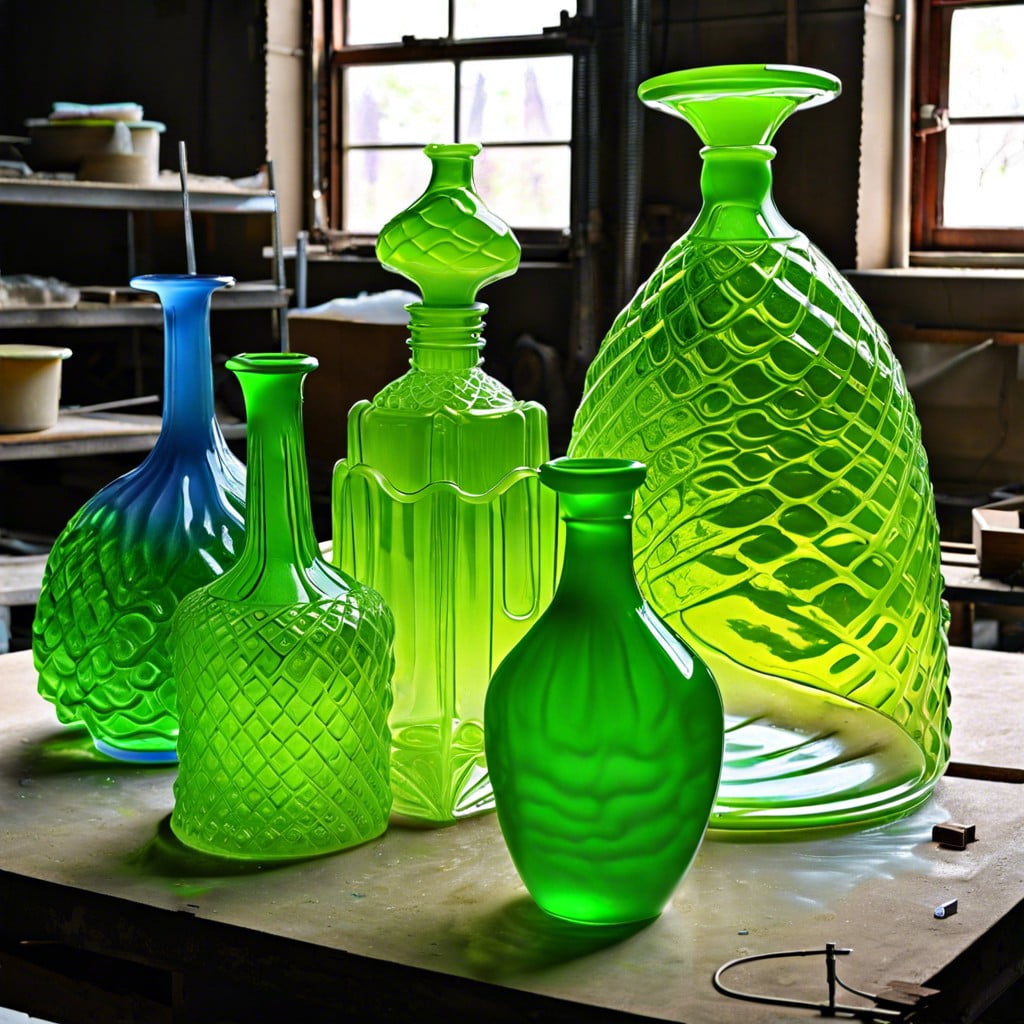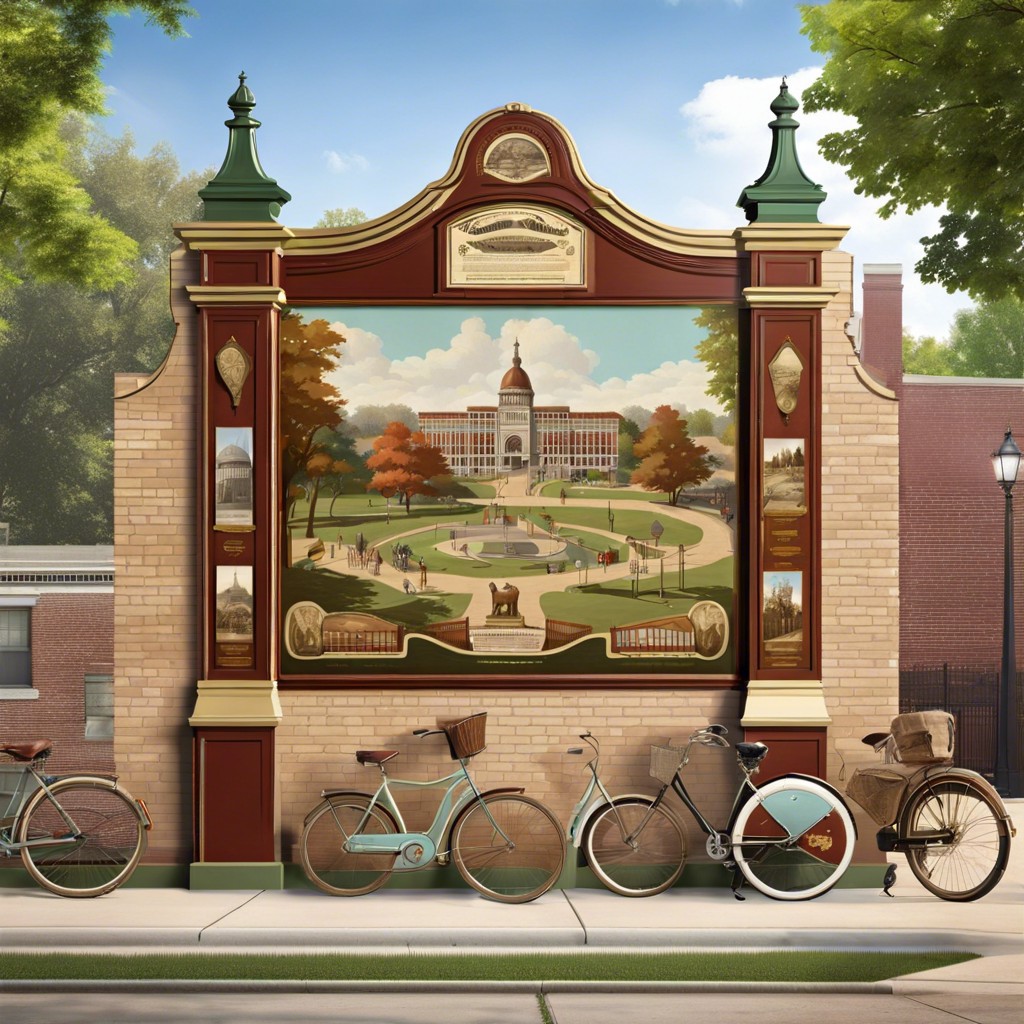Last updated on
Dive into the world of Vaseline Glass because its fascinating history and unique properties are nothing short of magical.
Key takeaways:
- Vaseline glass exhibits a distinct neon-like glow under ultraviolet light.
- It is produced by incorporating small amounts of uranium into the glass mix.
- Vaseline glass has been used for household items, jewelry, and more.
- While it is generally safe, precautions should be taken when handling and storing.
- Market value is influenced by factors such as age, condition, and rarity.
Appearance

Exhibiting a distinct neon-like glow under ultraviolet light, this type of glassware typically showcases a yellow to yellow-green hue when viewed in natural light. The characteristic coloration stems from the presence of uranium dioxide. The intensity of the color can vary greatly, ranging from subtle and almost clear to a deep, rich green. Its translucency may also range from opaque to fully transparent, permitting light to pass through, enhancing its soft, ethereal quality.
Daylight brings out a warm, greenish-yellow cast, giving pieces an eye-catching, vibrant quality that has contributed to its popularity among collectors. The unique visual properties make this glass instantly recognizable and highly coveted.
Fabrication

Vaseline glass is produced by incorporating small amounts of uranium dioxide or oxide into the glass mix before melting. This element gives the glass its characteristic yellow-green color, which is particularly striking under ultraviolet light. The practice peaked in popularity during the late 19th and early 20th centuries. Typically, the amount of uranium can vary from as little as 0.1% to as much as 25%, affecting the intensity of the green coloration.
The production process is similar to other glass-making methods and begins with the basic components of silica sand, soda, and lime. Once these materials are combined, the uranium compound is added. The entire mixture is then melted in a furnace at temperatures ranging from 2,192 to 2,642 degrees Fahrenheit. After the molten glass achieves a uniform consistency, it is molded or blown into desired shapes and allowed to slowly cool and harden.
Manufacturers sometimes enhance the color through additional heat treatments and by adding other metal oxides. The precise makeup of Vaseline glass varies among producers and historic periods, generating a range of colors and properties within the Vaseline glass category. It’s worth noting that contemporary environmental and safety regulations influence modern production techniques, ensuring that new Vaseline glass items comply with current safety standards.
Usage
Historically used in the late 19th and early 20th centuries, the unique glow of Vaseline glass has made it a popular item for various applications. Manufacturers produced a range of household items including bowls, figurines, vases, and drinking glasses, as well as more utilitarian pieces like electrical insulators and even buttons.
In contemporary times, while the production of new items has decreased, collectors and vintage enthusiasts continue to seek out Vaseline glass for its distinctive appearance and historical value. Its fluorescent quality is particularly cherished among glass collectors and is often highlighted in display cabinets with ultraviolet light to accentuate its greenish-yellow hue.
Artisans also still craft jewelry from Vaseline glass beads, maintaining the connection with the past and preserving the unique craftsmanship associated with this glass. Additionally, Vaseline glass continues to be studied and admired for its role in glassmaking history and the technological advancements of the time period during which it was most popular.
Health Concerns
Due to the uranium content in vaseline glass, there may be concerns about its safety and potential radiation risk. However, the levels of radiation emitted are generally considered low and often comparable to the natural background radiation we are exposed to daily. Despite this, it is recommended that food and beverages not be stored in these vessels to minimize any risk of ingestion.
For collectors or those handling vaseline glass regularly, it’s advisable to limit direct contact, especially if the glassware is broken or powdered, as inhaled or ingested uranium can be hazardous. Displaying these items in living spaces is considered safe, but as a precaution, they should be kept out of reach of children.
While deemed safe for general handling and display, the USA’s Nuclear Regulatory Commission does not require vaseline glass to be regulated as radioactive material. However, it’s wise to use common sense and take measures to reduce exposure such as handwashing after handling, and not using these items as everyday tableware.
Vaseline Glass Vs. Uranium Glass
While both Vaseline glass and uranium glass contain uranium dioxide, giving them a characteristic green color, there are differences worth noting.
Vaseline glass has a higher proportion of uranium, leading to its distinctively greener, almost neon hue.
This glow is especially prominent under ultraviolet light.
Conversely, uranium glass typically has a lower uranium content, which results in a broader range of colors, from green to yellow, and a less intense fluorescence.
Moreover, Vaseline glass is often glossier than uranium glass, owing to the use of different production techniques and materials beyond the uranium itself.
To distinguish between the two, collectors will frequently rely on a UV light test or seek documentation of the glass’s composition and provenance.
Identification Methods
Determining whether a piece of glass is true Vaseline glass involves a few key techniques:
1. Ultraviolet Light Test: When exposed to ultraviolet light, such as from a blacklight, Vaseline glass will fluoresce a bright green due to its uranium content. This is the most definitive test.
2. Visual Inspection: Vaseline glass typically has a yellowish-green hue that is somewhat transparent. The color can vary depending on the lighting but generally possesses a characteristic glow.
3. Maker’s Marks and Patterns: Researching the specific marks or patterns on the glass can reveal its authenticity. Collectors often refer to pattern books and maker’s mark databases to verify Vaseline glass pieces.
4. Expert Consultation: For valuable or uncertain pieces, consulting a professional appraiser or a knowledgeable collector may provide clarification.
5. Geiger Counter: An unusual but conclusive method, a Geiger counter can detect the low-level radioactivity emitted by the uranium within the glass.
By applying these methods, collectors and enthusiasts are typically able to confirm the identity of Vaseline glass with confidence.
Comparison With Other Types of Glass
Unlike typical glassware, Vaseline glass possesses a unique yellow-green hue due to its uranium content. This characteristic distinguishes it from other types of glass that rely on metallic oxides for coloring, such as cobalt for blue glass or gold chloride for red glass.
It stands out for its capacity to fluoresce under ultraviolet light, a trait not common in ordinary colored glass. When compared to lead crystal, known for its high refractive index and brilliant sparkle, Vaseline glass has a softer luster and rarely possesses the same clarity or weight.
In contrast to frosted or satin glass that achieves its finish through acid etching or sandblasting to create a diffused appearance, Vaseline glass maintains a translucent to semi-opaque quality with a glossier finish.
While Depression glass, produced during the 1920s to 1940s, shares a similar time period of production and sometimes color, it does not contain uranium and therefore does not glow under UV light. Additionally, Depression glass typically features patterns and was mass-produced, making it more common and less valuable than Vaseline glass.
Market Values
Determining the market value of vaseline glass can be influenced by several factors including age, condition, rarity, and the presence of a maker’s mark. Antique pieces, especially those produced before the 1940s, often fetch higher prices due to their historical significance and reduced availability. Meanwhile, discontinued patterns or those from esteemed manufacturers like Northwood or Fenton also command a premium.
Condition plays a critical role; items free from chips, cracks, or repairs are more desirable to collectors and thus, more valuable. Additionally, certain colors or shapes may be more in demand, affecting the price. Collectors often value complete sets or pieces that are part of a series more highly than individual items.
It’s important to research recent auction results or consult price guides specific to vaseline glass to understand current market trends. Online auction sites can provide a snapshot of what collectors are willing to pay, but prices can vary significantly between private sales and professional auctions.
When considering a purchase, prospective buyers should seek reputable dealers or attend specialized glass shows and auctions to find authentic, fairly-priced pieces. Whether you are an enthusiast or a novice collector, understanding these market dynamics can aid in making informed decisions when adding to a collection or appraising existing pieces.
Collection Tips
Begin by researching historical production periods and prominent manufacturers to identify reputable sources of Vaseline glass.
When evaluating potential additions to a collection, inspect pieces under UV light to authenticate their uranium content, ensuring the characteristic green glow.
Prioritize quality over quantity; look for items free of chips, cracks, or significant wear that could depreciate value.
Educate yourself on the typical price range for various Vaseline glass items to avoid overpayment.
Network with other collectors through clubs, online forums, and antique shows to gain insights and discover unique pieces.
Keep a detailed inventory of your collection, including photographs and provenance for insurance and legacy purposes.
Always handle with care, as Vaseline glass is collectible as much for its historical significance as for its unique luminescence.
Safety Regulations
In response to concerns about radioactivity, the U.S. Nuclear Regulatory Commission (NRC) exempts vaseline glass containing uranium from most licensing requirements under specific conditions: the uranium content must be natural or depleted, it should not pose a significant risk to public health and safety, and the glass cannot be used in a way that could disperse the uranium.
Similarly, the Environmental Protection Agency (EPA) does not regulate these items as they are considered to pose minimal environmental risk.
Collectors are advised to store their vaseline glass collections safely, in locations where the public and especially children, would not have direct, frequent access.
While normal handling of vaseline glass is generally considered safe, prolonged exposure should be avoided.
For example, it is not recommended to use vaseline glassware for food or beverage storage or consumption.
It’s worth noting that contemporary vaseline glass producers must comply with strict safety standards to minimize hazards.
These regulations ensure that newly manufactured vaseline glass has much lower levels of radioactivity compared to antique pieces.
When transporting vaseline glass, particularly in large quantities, it’s prudent to consult relevant local guidelines which may differ by region based on their specific health and safety protocols.




